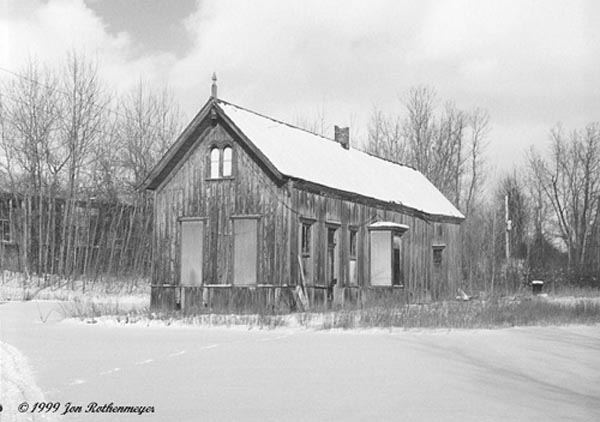Perkinsville, NY
Many years ago an article in Trains magazine delved into
"Whatís Left of Lackawanna". This explored the late Delaware,
Lackawanna and Western, the "Road of Anthracite" and "Route of
the Phoebe Snow". Now we visit a ghost railroad, an abandoned depot, a
right of way stripped of rails and ties but a place not without memories of the
glory days. What was the DL&W? Let us journey to Western New York and
Perkinsville, NY to seek an answer.
In itís heyday the Lackawanna was a strong, well run
operation. After several decades in the late 19th Century as a sleepy
provincial operation, (the railroad didnít even run Sunday passenger trains)
the railroad in 1899 assumed a new president, one who would lead the company
into the new century. William Haynes Trusdale is credited with making the
DL&W one of the great railroads of North America. His leadership brought
forth an amazing modernization and building program that few railroads, if any,
were able to match. Trusdale oversaw almost a complete rebuilding of the
DL&W from New Jersey to Buffalo. The railroad became known as "Mile for
Mile the most Highly Developed Road in America".
The Delaware, Lackawanna & Western began life in the
anthracite coal region of eastern Pennsylvania. Like oil is today, coal was the
energy source of the 19th and early 20th Centuries. The
industrial revolution was maturing and a reliable source of fuel was at hand in
the mountains to be found in the coal regions. Anthracite coal in particular was
a preferred fuel source after a way of efficiently burning it was perfected. The
clean burning properties were much touted by the DL&W and the road did much
to promote itís use as a locomotive fuel. Mark Twain once remarked on a
journey he took aboard the DL&W: "donned white duck suit this morning
in Buffalo and am now arrived in New York and it is white still". All this
in the days of open window coaches!
Scranton, Pa. became the focus of many railroads, and the
DL&W eventually grew into a New York City to Buffalo route that serviced the
heart of the industrial east. Itís rivals included the Erie and Lehigh Valley,
but they were really poor cousins to the kingly, well heeled "Road of
Anthracite". The railroad expanded first east to New York tidewater by
acquiring the Morris & Essex. This line would eventually become part of the
mainline and would be heavily rebuilt in the early 20th century.
Magnificent passenger stations would rise all along the road, and complemented
the massive grade separations and road re-alignment projects that positioned the
DL&W as a superior property.
DL&Wís western extension to Buffalo would be constructed
in the late 1870ís. Although there were many examples of DL&W modern
depots, western New York is still fortunate to retain several of the originals
as well. Perkinsville station, (originally called Portway, but officially
renamed in 1935) was built in 1882. Railroad maps place it at milepost 313.2. A
family appearance to DL&W wood depots on the Buffalo line is very common.
Typical details include a curving roof overhang, board and batten siding, and
tall multipane windows. The graceful support brackets and typically Victorian
details made for a very pleasing depot. Original paint colors of many DL&Wís
depots were a rich green. Avoca, NYís restored DL&W depot is a good
example of the color scheme. Perhaps Perkinsville also followed suit.
For many years fast freights headed by Pocono class 4-8-4ís
highballed past the depot on the superbly maintained right of way. Passenger
service on the railroad was among the finest in the east, with the Phoebe Snow
as the flagship service. After World War II, the diesels arrived and so did a
revived Phoebe Snow, sporting the famous tavern lounge observation car on itís
streamlined consist.
Traditional railroading underwent dramatic, if gradual, changes
in the late 1940ís through the 1950ís as steam gave way to diesel, freight
traffic began to slip and more and more passengers forsake the railroad in favor
of the automobile and air travel.
In 1960, DL&W merged with rival Erie Railroad. The combined
railroad began to rationalize, and DL&Wís Buffalo mainline was downgraded
and then eliminated as a through route. Eventually, the right of way would be
abandoned altogether and the tracks rails and ties would be scrapped. Somehow
the Perkinsville depot survived while many of her sister stations would
disappear.
Today the right of way can still be seen, especially in the
winter months. In the hush of a quiet winter afternoon, as the sun becomes low
on the horizon, we visited the Perkinsville station. Perhaps some would say it
forlorn and an eyesore and that it would be better off torn down. Nature is
slowly but relentlessly tugging at the right of way, now used by snowmobilers.
But step onto the former platform area and listen carefully. A ghost train
whistle sounds down the line for the station stop. The clatter of countless
trains and panting steamers passing the old depot can be conjured up, and Miss
Phoebe herself can be imagined waving from a turn of the century open platform
car rounding the curve past the depot.

The small town of Perkinsville was well served
by Miss Phoebeís railroad during the heyday of the DL&W. Photo by Jon
Rothenmeyer, New Yearís Day, 1999
More
photos of Perkinsville